- 13 - 14 AOÛT
- INDI-UNI : Online Courses / Cours à distance
PRE-INSCRIPTION : 15 Juin – 15 Août
PRE-REGISTRATION: June 15th - August 15th
- KAZAKHSTAN - Akkol Jayilma - Un grand mausolée datant de l'époque de la Horde d'Or a été découvert non loin de la ville d'Ekibastouz dans l'est du Kazakhstan, a annoncé vendredi le chef d'une expédition archéologique, Timour Smagulov. Un mausolée datant du XIVe siècle de notre ère a été mis à jour lors de fouilles sur le site archéologique unique en son genre Akkol Jayilma. "Cet édifice est l'une des plus grandes constructions archéologiques sur le territoire de Saryarka (steppe au centre du Kazakhstan, ndlr). Haut de 20 mètres, le mausolée contient la dépouille d'un représentant de l'élite", a indiqué M.Smagulov. En outre, les archéologues ont découvert des ateliers médiévaux, des systèmes d'irrigation originaux et des pièces de monnaie en argent et en cuivre battues en Europe orientale et en Chine. "Les carreaux décoratifs couvrant les murs du mausolée représentent un intérêt particulier. Un ornement géométrique comprenant des signes mystérieux, que les archéologues devront déchiffrer, y sont sculptés.
http://fr.rian.ru/science/20110812/190459387.html
- BELGIQUE – 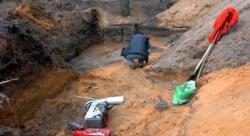 Gand - Des structures funéraires datant de l'âge de bronze ont été découvertes à la suite de fouilles sur un site archéologique gantois. Les archéologues inspectaient depuis fin mai un terrain de 5,8 hectares sur le site archéologique du Hogeweg, à Gand. Les résultats, après environ deux mois de fouilles, dépassent les attentes des chercheurs, selon les autorités communales. "A ce stade, le site semble être composé de six structures funéraires que nous venons de découvrir et d'une déjà connue mais qui doit être prise en compte dans ces nouvelles fouilles." L'aspect de chacune des différentes structures funéraires varie beaucoup. Ainsi, la plus petite a un diamètre de 17 mètres alors que la plus grande fait 55 mètres de circonférence. Les recherches ont aussi sorti de terre neuf habitations datant de l'âge du fer et de l'époque romaine. "Les vestiges comprennent un puits, des silos de provisions, des structures d'entrepôts et des plans complets des maisons. Au nord de la zone, nous avons aussi trouvé les restes d'une route romaine." Enfin, les archéologues ont découvert des traces de la Seconde Guerre mondiale. Un peu plus d'un kilomètre de tranchée et quelques cratères de bombes ont été mis au jour.
Gand - Des structures funéraires datant de l'âge de bronze ont été découvertes à la suite de fouilles sur un site archéologique gantois. Les archéologues inspectaient depuis fin mai un terrain de 5,8 hectares sur le site archéologique du Hogeweg, à Gand. Les résultats, après environ deux mois de fouilles, dépassent les attentes des chercheurs, selon les autorités communales. "A ce stade, le site semble être composé de six structures funéraires que nous venons de découvrir et d'une déjà connue mais qui doit être prise en compte dans ces nouvelles fouilles." L'aspect de chacune des différentes structures funéraires varie beaucoup. Ainsi, la plus petite a un diamètre de 17 mètres alors que la plus grande fait 55 mètres de circonférence. Les recherches ont aussi sorti de terre neuf habitations datant de l'âge du fer et de l'époque romaine. "Les vestiges comprennent un puits, des silos de provisions, des structures d'entrepôts et des plans complets des maisons. Au nord de la zone, nous avons aussi trouvé les restes d'une route romaine." Enfin, les archéologues ont découvert des traces de la Seconde Guerre mondiale. Un peu plus d'un kilomètre de tranchée et quelques cratères de bombes ont été mis au jour.
http://www.rtbf.be/info/societe/detail_mise-au-jour-de-tombes-de-l-age-du-bronze-lors-de-fouilles-a-gand?id=6579303
- ESPAGNE – 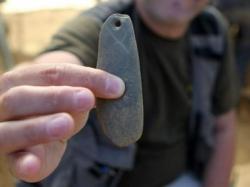 Irikaitz - A pendant dating back more than 25,000 years is the latest treasure to be hauled from the Irikaitz deposit in Spain’s Basque Region. Alvaro Arrizabalaga, excavation director said the 10cm pendant is very well preserved and will be removed to a public museum from the dig, located 20 km from San Sebastian near the border with France. Arrizabalaga says the stone was hung from a cord around a person’s neck, while it was also used as a tool to retouch the edges of tools made from flint. Pieces up to 250,000 years old have been discovered at the Irikaitz deposit, since it was studied by archaeologists in 1998.
Irikaitz - A pendant dating back more than 25,000 years is the latest treasure to be hauled from the Irikaitz deposit in Spain’s Basque Region. Alvaro Arrizabalaga, excavation director said the 10cm pendant is very well preserved and will be removed to a public museum from the dig, located 20 km from San Sebastian near the border with France. Arrizabalaga says the stone was hung from a cord around a person’s neck, while it was also used as a tool to retouch the edges of tools made from flint. Pieces up to 250,000 years old have been discovered at the Irikaitz deposit, since it was studied by archaeologists in 1998.
http://www.irishweatheronline.com/news/earth-science/archaeology/25000-year-old-pendant-discovered-during-basque-dig/31828.html
- INDE – Kuppanagar - Antiques including pottery and conches belonging to the Satavahana period (1st-2nd centuries AD) were unearthed in a recent exploration conducted by the archaeology department officials at Kuppanagar in Medak district. Archaeology and museums department director Prof P Chenna Reddy on Friday said that Kuppanagar is a habitation of the Satavahana period like Kohir, Nirjappala, Manthuru, Rekulapadu and Mominpet which were excavated by the archaeology department in the early 80s. The officials also found a stone plaque depicting a couple carved in typical Satavahana period prompting the officials to intensify the explorations in and around Kuppanagar to know the extent of the site.
http://expressbuzz.com/cities/hyderabad/satavahana-antiques-excavated/303872.html
- BULGARIE – 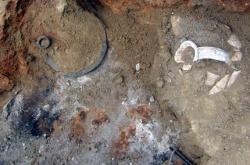 Mogilets - Bulgarian archeologist announced Friday the latest precious and unique finds in the country, discovered near the village of Mogilets in the area of the town of Omurtag in northeastern Bulgaria. 100 objects have been found during the digs of 5 tombs. The area around Mogilets is the most researched in the entire Targovishte region because it has a large number of mounds and a villa, dating from Roman times, as a geo-magnetic test had shown. The place is also among the very few in Bulgaria that have been spared from illegal treasure hunters. Archeologist, Stefan Ivanov says four of the tombs are in close proximity to each other. The way the burials have been done leads to the conclusion the toms date from Thracian times.
Mogilets - Bulgarian archeologist announced Friday the latest precious and unique finds in the country, discovered near the village of Mogilets in the area of the town of Omurtag in northeastern Bulgaria. 100 objects have been found during the digs of 5 tombs. The area around Mogilets is the most researched in the entire Targovishte region because it has a large number of mounds and a villa, dating from Roman times, as a geo-magnetic test had shown. The place is also among the very few in Bulgaria that have been spared from illegal treasure hunters. Archeologist, Stefan Ivanov says four of the tombs are in close proximity to each other. The way the burials have been done leads to the conclusion the toms date from Thracian times.
http://www.novinite.com/view_news.php?id=131075
- ROYAUME UNI – 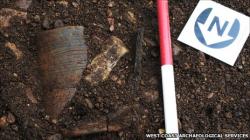 Skye - An archaeologist has uncovered the remains of an ancient burial cist and pottery at the site of a health centre on Skye. No human remains have been found, but further excavations and chemical tests on material recovered will delay the building project. Archaeologist Steven Birch also found a cairn and an underground structure known as a souterrain. The finds could date from the Iron Age. Mr Birch, of West Coast Archaeological Services, said: "Not only did we uncover the remains of an intriguing cairn-like structure, but there were numerous other features, including a grain-drying kiln, an underground stone-lined passage and a burial cist containing a ceramic Beaker vessel. "
Skye - An archaeologist has uncovered the remains of an ancient burial cist and pottery at the site of a health centre on Skye. No human remains have been found, but further excavations and chemical tests on material recovered will delay the building project. Archaeologist Steven Birch also found a cairn and an underground structure known as a souterrain. The finds could date from the Iron Age. Mr Birch, of West Coast Archaeological Services, said: "Not only did we uncover the remains of an intriguing cairn-like structure, but there were numerous other features, including a grain-drying kiln, an underground stone-lined passage and a burial cist containing a ceramic Beaker vessel. "
http://www.bbc.co.uk/news/uk-scotland-highlands-islands-14509160
- EGYPTE – 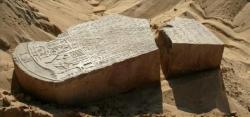 Tel Dafnah - The SCA have announced that a team of Egyptian archaeologists have discovered a stela dating to the time of Pharaoh Apries of Dynasty XXVI (589-570 BC) in the province of Ismailiya, east of Cairo at the site of Tel Dafnah (near Qantara West). The red sandstone stela is in two parts, carved with hieroglyphs including the king's name in cartouches. SCA head Mohamed Abdel Maqsud. It was thought to have come from a large temple at the site. Maqsud says that the archaeological findings in this field have found that Tel Dafnah was not only a former military fortress of Greek mercenaries, but a settlement Egyptian built by the pharaoh erected Psamtik I, second king of Dynasty XXVI.
Tel Dafnah - The SCA have announced that a team of Egyptian archaeologists have discovered a stela dating to the time of Pharaoh Apries of Dynasty XXVI (589-570 BC) in the province of Ismailiya, east of Cairo at the site of Tel Dafnah (near Qantara West). The red sandstone stela is in two parts, carved with hieroglyphs including the king's name in cartouches. SCA head Mohamed Abdel Maqsud. It was thought to have come from a large temple at the site. Maqsud says that the archaeological findings in this field have found that Tel Dafnah was not only a former military fortress of Greek mercenaries, but a settlement Egyptian built by the pharaoh erected Psamtik I, second king of Dynasty XXVI.
http://egyptology.blogspot.com/
- USA – Bath - Work began in Bath this summer on a four-year project to recreate a slice of maritime history. High school students, volunteers and two professional shipwrights are building a replica of a 17th century sailing ship--and not just any 17th century sailing ship: The Virginia is thought to be the first vessel built by English settlers in North America. It all took place in 1607 at the mouth of the Kennebec in Maine's Popham Colony, which eventually became Phippsburg. Four hundred years later, a few miles up the river in the ship-building town of Bath, the Virginia is being built once more--from scratch.
http://www.mpbn.net/Home/tabid/36/ctl/ViewItem/mid/3478/ItemId/17583/Default.aspx
- FRANCE –  Lille - Dans le cadre du chantier du réaménagement du stade Grimonprez-Jooris, une campagne de fouilles préventives menée par l’Institut National de Recherches Archéologiques Préventives (INRAP) a mis à jour des vestiges d’une partie des fondations de la citadelle. Selon l’INRAP, il s’agit d’un mur du premier système défensif de la place, au nord de la citadelle Vauban proprement dite. Celui-ci était composé de matériaux locaux : gré de Béthune, brique de la Lys et pierre de Lezennes. Les archéologues ont, par ailleurs, retrouvé au centre du site le lit du Bucquet, un petit cours d’eau mentionné au XIIIe siècle. Les excavations ont été rebouchées pour des raisons de sécurité. Par ailleurs, les fouilles préventives servent à établir un diagnostic sur la valeur du patrimoine.
Lille - Dans le cadre du chantier du réaménagement du stade Grimonprez-Jooris, une campagne de fouilles préventives menée par l’Institut National de Recherches Archéologiques Préventives (INRAP) a mis à jour des vestiges d’une partie des fondations de la citadelle. Selon l’INRAP, il s’agit d’un mur du premier système défensif de la place, au nord de la citadelle Vauban proprement dite. Celui-ci était composé de matériaux locaux : gré de Béthune, brique de la Lys et pierre de Lezennes. Les archéologues ont, par ailleurs, retrouvé au centre du site le lit du Bucquet, un petit cours d’eau mentionné au XIIIe siècle. Les excavations ont été rebouchées pour des raisons de sécurité. Par ailleurs, les fouilles préventives servent à établir un diagnostic sur la valeur du patrimoine.
http://www.lillemetropole.fr/index.php?p=21&art_id=19914
- FRANCE – 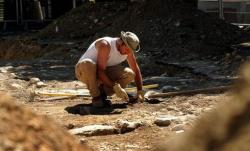 Brioux sur Boutonne - Pour les historiens, la découverte archéologique de Brioux-sur-Boutonne n'en est pas une. Dès le XIX e siècle, des érudits avaient tracé un inventaire assez précis des richesses de l'ancienne cité gallo-romaine Brugialum. Dès l'antiquité, Brioux fut une « agglomération secondaire », entre Poitiers et Saintes, doté d'un important réseau de voies. De nombreux vestiges témoignent de cette présence antique, notamment des inhumations et des traces d'une voie gallo-romaine. La complexité du site tient à l'entrelacs de plusieurs époques. La nécropole mérovingienne, entre la mairie et l'église, comporterait plusieurs dizaines de sarcophages : « Elle est très bien préservée, d'autant que cette place a été remaniée plusieurs fois », observe Emmanuel Moizan, responsable des fouilles (INRAP). S'enchevêtrent, des éléments de constructions médiévales autour d'une première église.
Brioux sur Boutonne - Pour les historiens, la découverte archéologique de Brioux-sur-Boutonne n'en est pas une. Dès le XIX e siècle, des érudits avaient tracé un inventaire assez précis des richesses de l'ancienne cité gallo-romaine Brugialum. Dès l'antiquité, Brioux fut une « agglomération secondaire », entre Poitiers et Saintes, doté d'un important réseau de voies. De nombreux vestiges témoignent de cette présence antique, notamment des inhumations et des traces d'une voie gallo-romaine. La complexité du site tient à l'entrelacs de plusieurs époques. La nécropole mérovingienne, entre la mairie et l'église, comporterait plusieurs dizaines de sarcophages : « Elle est très bien préservée, d'autant que cette place a été remaniée plusieurs fois », observe Emmanuel Moizan, responsable des fouilles (INRAP). S'enchevêtrent, des éléments de constructions médiévales autour d'une première église.
http://www.lanouvellerepublique.fr/LOISIRS/Patrimoine-tourisme/Les-riches-sous-sols-de-Brugialum